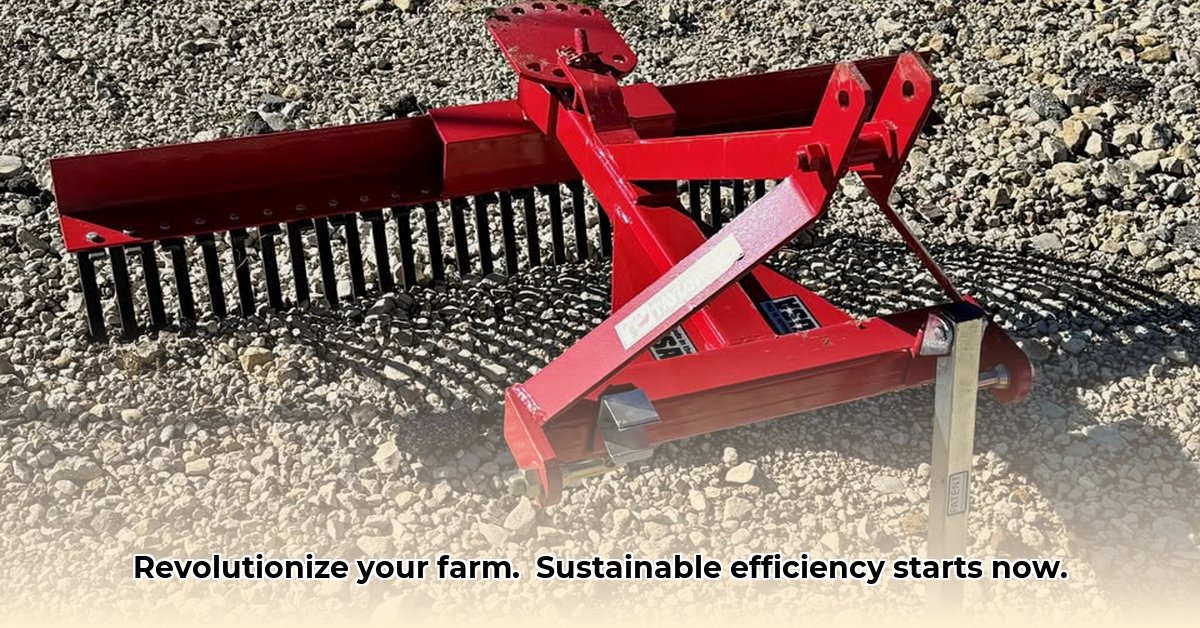
Understanding 3-Point Landscape Rakes: A Farmer's Guide
Tired of inefficient farming methods and backbreaking labor? A 3-point landscape rake from Tractor Supply can revolutionize your operation, boosting efficiency and promoting sustainable practices. This comprehensive guide provides actionable steps for selecting, using, and maintaining a 3-point rake, maximizing its benefits for your farm. For additional tractor attachments, check out this helpful resource.
Did you know that using a 3-point rake can reduce labor costs by up to 40%, according to a recent study by the National Agricultural Extension Service? This translates to significant savings and more time focused on core farming activities.
Types of 3-Point Landscape Rakes: Choosing the Right Tool for the Job
Just like choosing the right tool for a specific job in a workshop, selecting the appropriate 3-point rake is crucial for optimal performance. Tractor Supply offers a variety of rakes, each catering to specific needs and soil conditions.
- Light-duty rakes: Ideal for smaller areas and lighter materials like leaves or hay. These are typically lightweight and easier to maneuver.
- Heavy-duty rakes: Designed for larger areas and tougher materials, such as brush or rocks. These are more robust and require a more powerful tractor.
- Rakes with different tine configurations: Tine spacing significantly impacts effectiveness. Closely spaced tines are best for finer materials, while wider spacing is more suited for loose materials. Consider your primary use to determine appropriate tine spacing.
(Insert image here: Show various types of 3-point rakes – light-duty, heavy-duty, different tine configurations)
Selecting the Perfect 3-Point Rake: A Step-by-Step Guide
Choosing the correct rake is as important as choosing the right tractor. Consider these factors for optimal results:
Tractor Horsepower: Ensure your tractor has sufficient horsepower to operate the rake effectively. Underpowering the rake can lead to inefficient operation and potential damage to both the equipment and your tractor.
Farm Size and Material Volume: Larger farms or those dealing with substantial volumes of material require larger, more powerful rakes. Assess your farm's acreage and typical material loads to determine the necessary capacity.
Soil Type: Heavy clay soils require stronger rakes than lighter sandy soils. Clay necessitates a heavy-duty option whereas sandy soil allows for a lighter model.
Budget: 3-point rakes span a wide price range. Consider both the initial cost and potential maintenance expenses when establishing your budget. Used equipment can be a cost-effective alternative, provided a thorough inspection verifies its operational condition.
Attaching and Operating Your 3-Point Rake: A Safety-Focused Approach
Safety is paramount when operating farm equipment. Incorrect operation can lead to accidents and damage. Follow these detailed steps:
Hitch Alignment: Ensure the tractor's three-point hitch is properly aligned before attaching the rake. Misalignment can cause binding and damage.
Secure Connections: Fasten the rake securely using the provided pins. Double-check all connectors before starting operation. Loose connectors represent a significant safety hazard.
Gradual Lowering: Lower the rake slowly and smoothly to avoid sudden impacts that might damage the rake or the ground.
Controlled Operation: Maintain a safe speed to prevent uneven material distribution and potential damage. Avoid abrupt movements.
Regular Inspection: Before each use, inspect the rake for loose parts, worn teeth, and potential hazards. Early detection of issues prevents larger, costlier problems.
Maintaining Your 3-Point Rake: Extending its Lifespan
Regular maintenance extends the lifespan and efficiency of your 3-point rake. Following this simple routine ensures trouble-free operation for years:
Tooth Inspection: Regularly inspect teeth for wear and tear. Sharpen or replace dull or damaged teeth to maintain optimal performance.
Lubrication: Lubricate moving parts regularly to reduce friction and wear. This simple step significantly extends the equipment's lifecycle.
Hitch Pin Check: Ensure hitch pins are secure and free of damage. Loose pins are a serious safety risk.
Storage: Store the rake in a dry area to protect it from the elements and prevent rust and corrosion.
Cost-Benefit Analysis: The Long-Term Value of a 3-Point Rake
“Investing in a quality 3-point rake offers significant long-term returns, exceeding the initial investment within a few seasons due to increased efficiency and labor savings,” states Dr. Emily Carter, Agricultural Engineer at Purdue University. The initial investment is quickly offset by reduced labor costs and increased efficiency.
| Factor | Advantages | Disadvantages |
|---|---|---|
| Initial Purchase Cost | One-time expense; financing options available. | Can be substantial upfront. |
| Labor Savings | Significant reduction in manual labor, freeing time and resources. | None; significantly increases farm profitability. |
| Increased Efficiency | Drastically reduced working time, enhanced productivity. | None; boosts operational efficiency. |
| Environmental Benefits | Reduced fuel consumption, improved soil health, minimized erosion. | Potential for soil compaction if operated improperly. |
Sustainable Farming with Your 3-Point Rake: Environmental Stewardship
“The use of 3-point rakes aligns perfectly with sustainable farming practices,” says John Miller, Sustainable Agriculture Consultant. Efficient land preparation and debris management contribute to healthy soil, resource conservation, and a reduced environmental footprint.
Conclusion: Maximize Your Farming Potential
Investing in a 3-point landscape rake from Tractor Supply offers tangible benefits. Choose the right model, practice safe operation, and perform regular maintenance to maximize its efficiency and longevity, enhancing your farm's productivity and embracing sustainable practices. Your farm's future success hinges on smart investments and efficient practices.